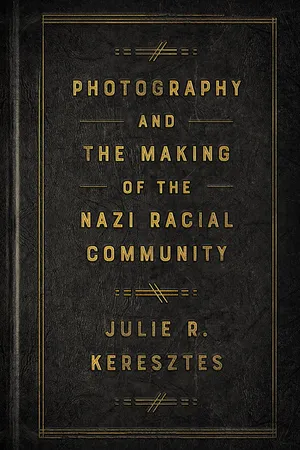
- 210 pages
- English
- ePUB (mobile friendly)
- Available on iOS & Android
Photography and the Making of the Nazi Racial Community
About this book
Photography and the Making of the Nazi Racial Community examines the role of photography in the construction of the Nazi Volksgemeinschaft, a racially exclusive community, during the Third Reich. Julie R. Keresztes explores how the dictatorship promoted photography for those who belonged to that community and excluded Jews from the practice. As Nazi officials dispossessed Jewish photographers and robbed them of their equipment, studios, and eventually their lives, they made photography more accessible to non-Jewish Germans. But they inadvertently created spaces for photography to be used as resistance and revenge in concentration camps, where forced laborers salvaged photographs that exposed the extermination of Europe's Jews.
As the victims of Nazi persecution used photography to gather evidence of the Holocaust, German troops and their families used photography to portray themselves as dutiful members of the Volksgemeinschaft rather than show the reality of war and genocide. Ultimately, Photography and the Making of the Nazi Racial Community shows how the configuration of photography along racial lines shaped the imagery of the Second World War.
Published in Association with the US Holocaust Memorial Museum.
Frequently asked questions
- Essential is ideal for learners and professionals who enjoy exploring a wide range of subjects. Access the Essential Library with 800,000+ trusted titles and best-sellers across business, personal growth, and the humanities. Includes unlimited reading time and Standard Read Aloud voice.
- Complete: Perfect for advanced learners and researchers needing full, unrestricted access. Unlock 1.4M+ books across hundreds of subjects, including academic and specialized titles. The Complete Plan also includes advanced features like Premium Read Aloud and Research Assistant.
Please note we cannot support devices running on iOS 13 and Android 7 or earlier. Learn more about using the app.
Information
Table of contents
- Acknowledgments
- Introduction
- Part I:
- Part II:
- Epilogue
- Notes
- Bibliography
- Index